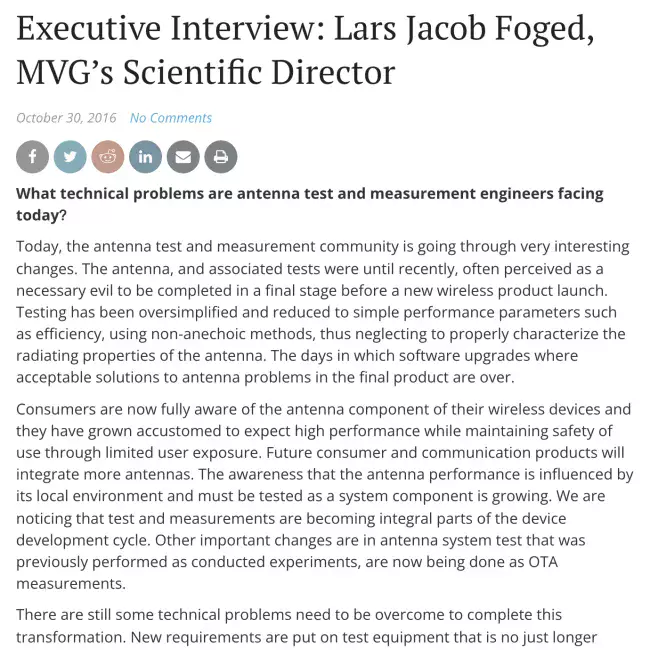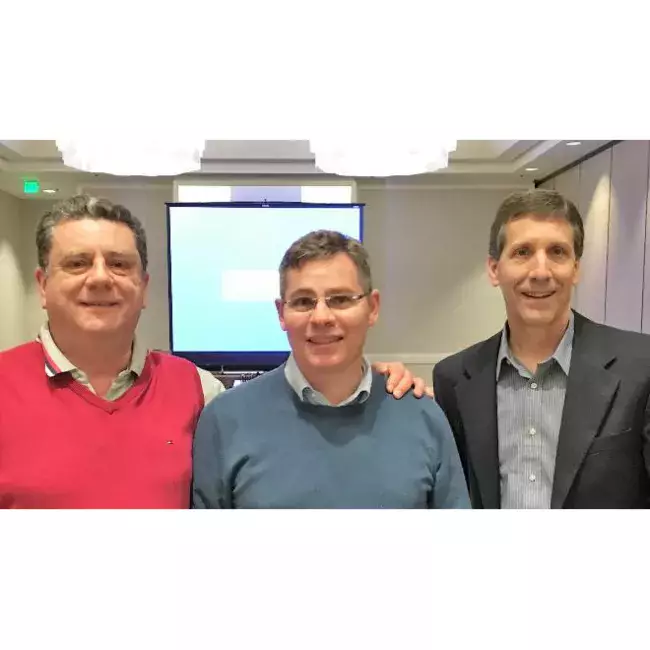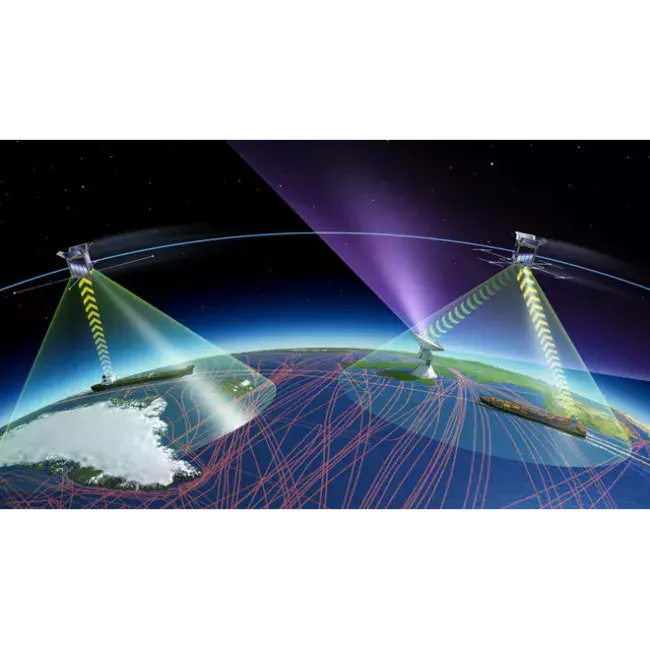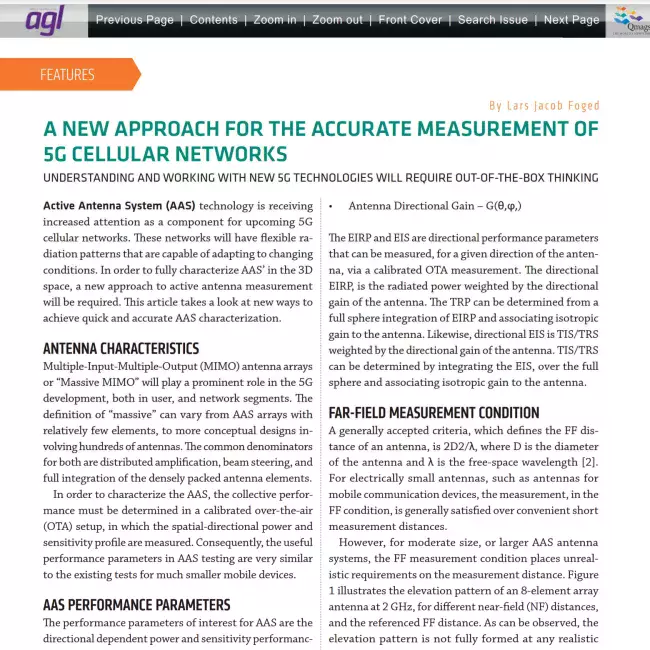媒体报道
我们在主要行业出版物上的引用。
我们在主要行业出版物上的引用。

MICROWAVE JOURNAL CHINA
On the occasion of the ESoA Summer courses which took place in China in August, Microwave Journal interviewed exclusively Lars Foged on antenna test and measurement technologies as well as MVG's competitve advantages.
Take a look at some very challenging questions the journalist asked:
"What technical problems are antenna test and measurement engineers facing today?"
"How do the emerging antenna technologies and applications such as antennas for 5G base stations and handsets, IoT devices, massive MIMO, commercial phased-arrays, 3D printing, metamaterials, etc., affect the methods and techniques of antenna test and measurement?"
"Which standards for antenna test and measurement are in development now? What’s the role of MVG in the international antenna test and measurement standards process?"
"Can MVG’s existing antenna test products and solutions meet all the testing requirements of all existing antennas? Whatever the frequency, power, size and form factor of an antenna are, and what scenarios are: on-site, in a production line or in a laboratory."
And more...
Check out Lars Foged's brillant answers and read the whole interview in English by clicking here!
Read the interview in Chinese by clicking here!

IEEE AP-S INDUSTRIAL INITIATIVES COMMITTEE
MVG’s Scientific Director, Lars Foged, has been nominated the 2016 Chair of the Industrial Initiatives Committee of the IEEE Antenna and Propagation Society (AP-S).
The IEEE AP-S brings together technological experts in antennas, including analysis, design, development, measurement, and testing; radiation, propagation, and the interaction of electromagnetic waves with discrete and continuous media; and applications and systems pertinent to antennas, propagation, and sensing.
The AP-S has a number of standing committees organized yearly. The main charter for the Industry Initiatives Committee is to represent the industrial community and to promote its interests in future AP-S activities. Lars will be contributing to activities that aim to gain recognition of the IEEE AP-S in the Industry, and to identify industry members for future Fellow and technical field awards.

ESA - COMPACT AIS ANTENNA
MVG is proud to have been part of a European project to develop a new antenna for the tracking of oceangoing vessels from space via Satellite.
A VHF array antenna was designed for mini-satellite platforms in Low Earth Orbit. In partnership with CGS, who piloted the project, MVG Italy developed the electromagnetic design, and manufactured and tested the array antenna.
News from ESA:
What might look like an abstract artwork is actually a novel antenna, small enough for a minisatellite, to track global ship traffic from orbit.
Commercial vessels are mandated to transmit Automatic Identification System (AIS) signals, which are used to track maritime traffic – the oceangoing equivalent of air traffic control. The system relies on VHF radio signals with a horizontal range of just 40 nautical miles (74 km), useful within coastal zones and on a ship-to-ship basis, but leaving open ocean traffic largely uncovered.
However, in 2010 ESA fitted an experimental antenna to Europe’s Columbus module of the International Space Station, demonstrating for the first time that AIS signals could also be detected from up in orbit, opening up the prospect of global ship tracking from space.
“Based on our testing, this new prototype designs offers a four-fold increase in ship detection performance,” explains ESA antenna specialist Nelson Fonseca, overseeing the project.
“The AIS detection system on Columbus employs a low-gain ‘whip’ antenna, receiving signals within a very broad beam, with corresponding potential for signal overlap and interference.
“This antenna design combines higher-gain with a more reduced footprint, allowing more of a focus on regions of highest interest, and can also discriminate between polarisations, increasing the likelihood of detection for any individual AIS signal within the antenna field of view.”
In addition, clever engineering has shrunk the overall antenna size to a size where up to five could be hosted on a single cubic-metre minisatellite.
“Despite its name, VHF is quite a low wavelength in space terms, implying a bulky antenna of about 1 m across and half-a-metre thick to operate ideally at that frequency,” Nelson adds.
“But the patterned square-shaped structure on the underlying face of our antenna changes the signal behaviour, enabling us to shrink the design to 50 cm width and 3 cm thickness – making it suitable for hosting on a smaller platform.”
The antenna was developed through ESA’s ARTES Advanced Research in Telecommunications Systems – Advanced Technology programme with Italian companies CGS as prime contractor and MVG as subcontractor in charge of the electrical design.
“CGS and MVG are highly interested in moving forward with the optimisation and environmental qualification of this outstanding antenna element,” explains Andrea Di Cintio, managing the project at CGS. “The next step will be to identify a specific mission and then optimise the design and qualification accordingly.”
“Significant reduction of antenna dimensions and weight without compromising electrical performance was challenging,” adds Andrea Giacomini, lead antenna designer at MVG. “It required a radical change in the design and validation approach. We are proud to have been involved.”

INVESTOR
Active Antenna System (AAS) technology is receiving increased attention as a component for upcoming 5G cellular networks. These networks will have flexible radiation patterns that are capable of adapting to changing conditions. In order to fully characterize AAS’ in the 3D space, a new approach to active antenna measurement will be required. This article takes a look at new ways to achieve quick and accurate AAS characterization.